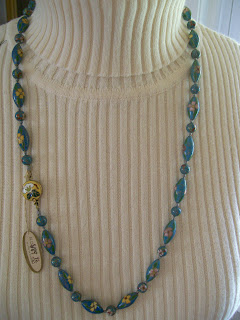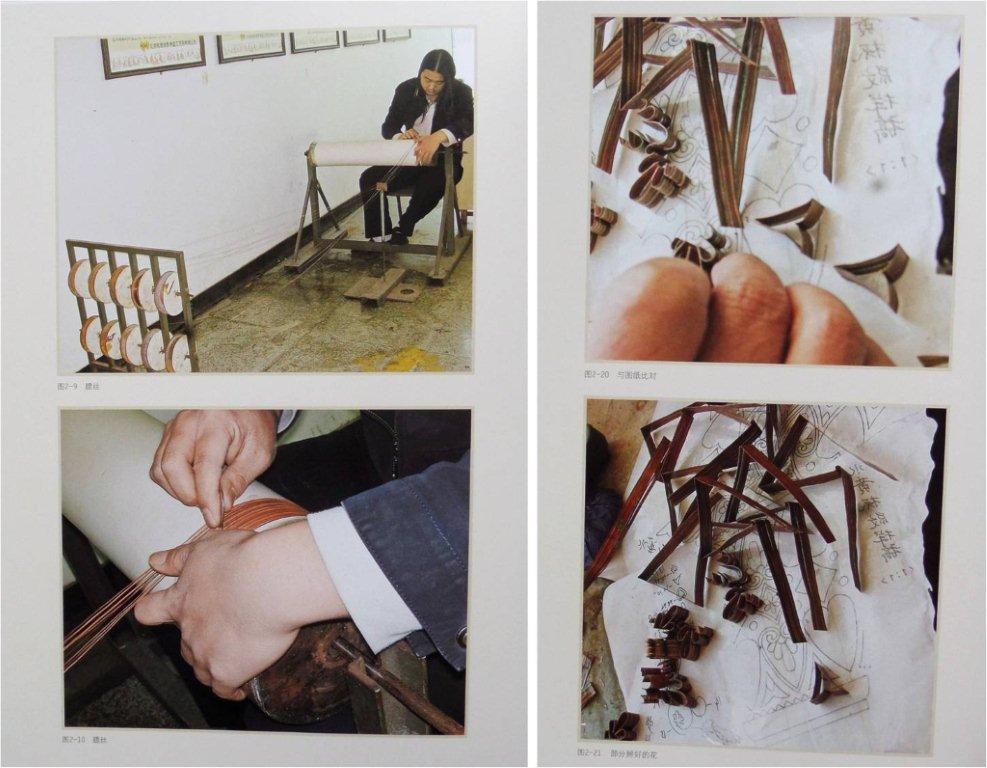Sifting through online auction items for Chinese cloisonné,
I noticed a trend in the style of clouds used in the background. From what I’ve learned about cloisonné
production methods, these little background motifs are useful for stabilizing the
enamel as it heats and melts, preventing it from dripping off the piece or
clumping up into blobs.
Let’s start with Lao Tian Li’s clouds – tight little rounded
things with a central hump and two round wings. The curves are plump and evenly
spaced with few noticeable flat spots, even in the central spirals. They’re placed evenly and precisely, with all
the curves going in the same direction.
On other pieces from the early 20th century the clouds
may have tighter central spirals, flat spots in the center curl or top or
bottom, be more unevenly applied, and sometimes have spirals going in opposite
directions. But they’re still tight,
rounded little motifs. I think of these
as “crinkle clouds” because of the kinks between the wings and the central
curve.
During the 1920s-40s production
methods in some workshops seem to have gotten more hurried and stereotyped, and
a longer (1-1.5cm) stretched cloud appears, with flattened top and bottom,
applied with varying degrees of evenness and in just enough quantity to not
overpower the design. An easy motif to
use for fitting between the parts of the main design, the larger size having
the benefit of covering more ground with fewer wires.
 |
| Smoking set with winsome dragon, accompanying letter dated 1942, from ebay seller particularpicker |
 |
| These all appear to be made by the same workshop, but have different base stamps. 1930s-1950s? |
In other pieces, the clouds are shorter and so thickly and
closely applied in neat horizontal rows that the background resembles lace or
crochet.
 |
The squared rims on these two vases seems to indicate a date 1930s-early 50s.
|
 |
| These small dishes show the "garden rock" base of the floral sprays displaying a similar comma leaf? bamboo shoot? motif to the green vase in the preceding picture. The black dish displays a "peaked spiral" diaper (see further below), the turquoise dish the "crinkle cloud." |
 |
The backs of the small dishes, both showing a red "CHINA" mark indicating production pre-1950 (the mark on the turquoise enamel is very faint)
|
Another style of cloud that persists into the 1950s-60s is what I term a "peaked spiral," a sort of more rounded creampuff shape compared to the stretched crinkle clouds. It appears on pieces from the 1920s through the 1960s. The yellow vases are from a 1920s department store, the red vases were purchased in Moscow in the 1950s.
Then the crinkle and peaked spiral clouds disappear, overtaken and replaced by
a little motif that instantly brands a piece as being produced after the 1950s,
and most likely during or after the 1970s:
 |
| One of several condiment sets on offer from eBay seller liwz88, who relates that these were made during the 1980s, but then stored in the factory warehouse for thirty years. |
Information available on the JingFa factory provides a clue
why this might have happened:
“Built in 1956, the
cloisonne factory is the biggest in China with 6 workshops and 1,800
workers. The “Beijing Enamel Brand” cloisonne wares are made in this
factory. They take up over 70 percent of cloisonne wares produced in China.
With a registered trade mark Jingfa, the products won an honourable title of
renowned product in Beijing in 1975. They were conferred the title of “top
quality product” by the Ministry of Light Industry in 1979, and again won the
prize of the National Hundred-Flower Golden Cup in 1981.” [TravelChinaNow: An Introduction to CloisonneFactory]
With production supervised for quality, especially during
the 60s-70s decade of the Cultural Revolution, who would feel safe diverging
from award-winning success and bucking the majority? Plus, this small and simple cloud motif has the
advantage of being more easily and uniformly replicated (possibly with a
standard issue specialized set of pliers?) and applied to fill in irregular
background areas. If neatness and exact
replication of a design are what the workshop overseers are looking for, this
motif is almost ideal. Do a Google Image search and you'll discover hundreds of photos showing cloisonne manufacture at Chinese workshops.
Beads that seem to date from the 1960s-80s often feature
tiny JingFa clouds in various sizes, sometimes open, sometimes closed, as well
as other spiral or peaked cloud motifs. But eventually, at least for cloisonné beads, just the cloud
and abbreviated shortened cloud and droplet shapes seem to be the sole
background motifs.
 |
| Exceptionally nice beads with high polish; clouds look a bit more quatrefoil. |
 |
| Butterflies and the JingFa swallow. |
 |
| Beads at top show spirals and "peaked" cloud motifs |
 |
| The blue beads match a strand from eBay with credible dating to the 1960s. Notice the small round beads feature spirals as well as the clouds. |
 |
| eBay necklace similar to turquoise beads in preceding photo. |
 |
| Information provided by eBay seller huskylover1955: "How do you know this is from the 1960s?" Answer: "My friend is Chinese and goes to China often to visit family. She purchased them there during that period." |
 |
| Spirals and clouds on strand on left. |
 |
| According to the eBay seller, they imported the white necklace in 1981. |
The JingFa cloud still continues to show up everywhere in
the background.
[Resplendent vases in factory showroom, 2010 - link has been 404'd as of 2023]
Although I await
contrary evidence, so far I have not seen a single piece of cloisonné that can
be reliably dated prior to the 1950s that contains this simple little cloud as
a background cover pattern; in other words, if you see it, the piece you are
examining is not an antique, and was produced within the last 50 years.
UPDATE: The biography of Jin Shiquan relates how he invented a contraption to produce multiples of wire motifs, especially the little background clouds otherwise so tedious to make.





























i think it's pretty damn interesting. thanks!
ReplyDelete